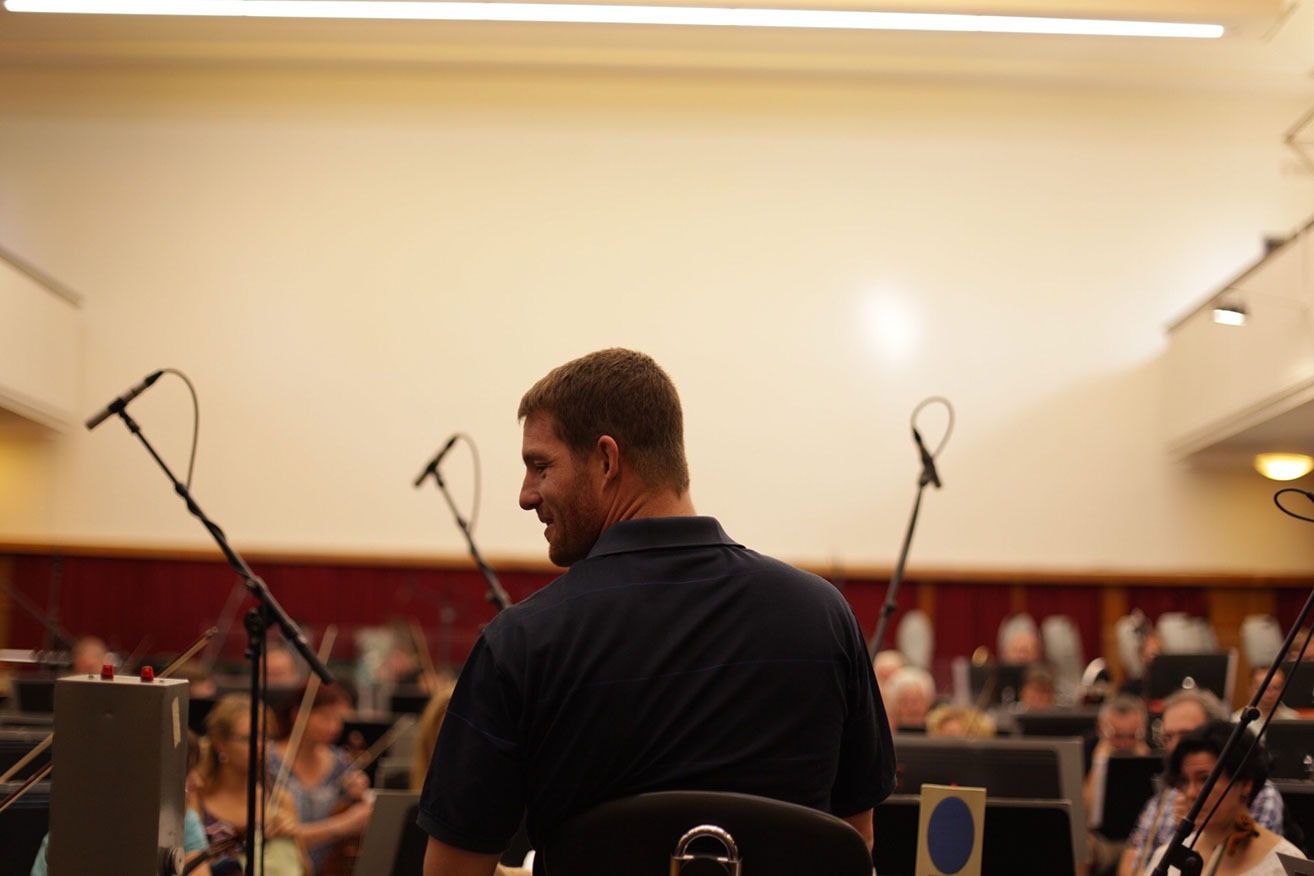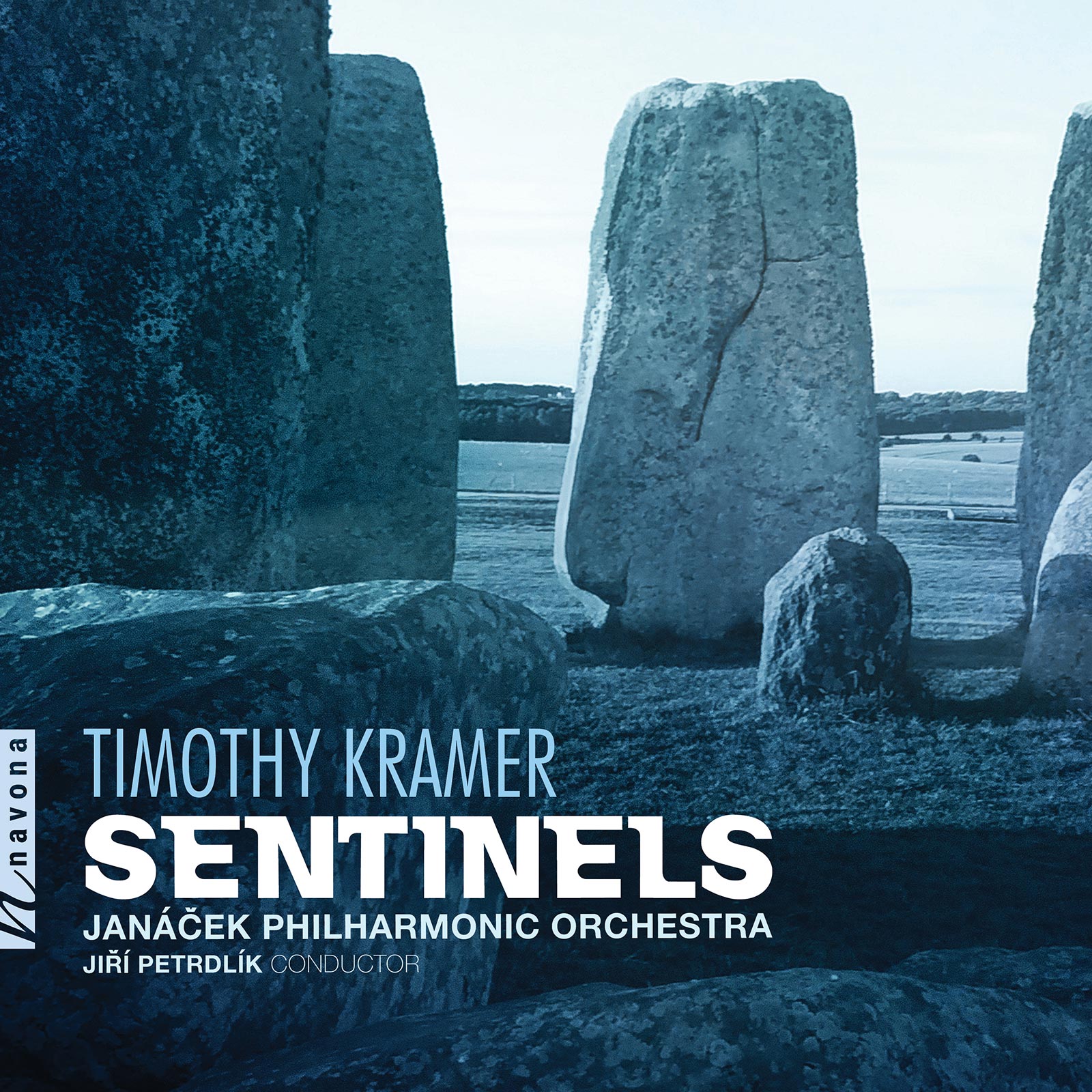
Share Album:
Sentinels
Timothy Kramer composer
Janáček Philharmonic Ostrava | Jiří Petrdlík conductor
Timothy Kramer has recorded and released a full album of his orchestral works with Navona Records. The result: SENTINELS, an evocative representation of Kramer’s compositions that span several decades, with influences ranging from Baroque to rock.
The title SENTINELS refers to the standing stones found in Stonehenge, featured in the album art. The bold, prominent horn introduction of BACH meets EsCHeR opens the album with a sense of mystery. This is the first movement of Symphony B-A-C-H, the largest work on the recording. Drawing from his training as a music scholar and theorist as well as a composer, Kramer chose to base each movement of this symphony on an overarching musical texture: the first focuses on polyphony, then monophony, homophony, and finally, cacophony. Everything is a deliberate choice: even the individual notes chosen by Kramer in certain sections can be “decoded” to reveal the names “Bach” and “Escher.”
Next comes A Fivescore Festival, a work commissioned by the City of Kent WA for their Centennial celebration. The piece, a series of four preludes and a rondo, has a spirit of resoluteness which imagines the city marching through successive generations toward the promise of the future. Sentinels of the Dance breaks from the traditionalism of the preceding piece, with the timpani and other instrument sections snarling and biting at each other with spontaneous, syncopated rhythms. Finally comes All in Golden Measure, another commissioned piece—this time for the Jacksonville Symphony Society celebrating the 50th anniversary of their Symphony Orchestra. Appropriately, Kramer chose to integrate the golden ratio into the fabric of this composition. Here, Kramer’s sensitivity to rhythm and timbre allows him to conjure up images of the train whistling through Jacksonville, the hissing of cicadas, and the electric excitement resonating through the summer air from the racetrack.
In SENTINELS, Timothy Kramer demonstrates both his mastery of traditional orchestral composition and his willingness to deviate boldly from those traditions. The album offers an impressive breadth of music that all may still, somehow, be rightly classified together as “orchestral.” Like a great novel or film, this collection invites the listener to listen again, and perhaps pick up a few more compositional gems hidden by Kramer that they had missed the first time.
Listen
Stream/Buy
Choose your platform
An Inside Look
Timothy Kramer - Sentinels | Janáček Philharmonic Orchestra
Track Listing & Credits
| # | Title | Composer | Performer | |
|---|---|---|---|---|
| 01 | Symphony "B-A-C-H": I. Bach Meets Escher | Timothy Kramer | Janáček Philharmonic Ostrava | Jiří Petrdlík | 8:52 |
| 02 | Symphony "B-A-C-H": II. Schizo Scherzo | Timothy Kramer | Janáček Philharmonic Ostrava | Jiří Petrdlík | 4:44 |
| 03 | Symphony "B-A-C-H": III. Meditation Chorale | Timothy Kramer | Janáček Philharmonic Ostrava | Jiří Petrdlík | 5:31 |
| 04 | Symphony "B-A-C-H": IV. Party Favors | Timothy Kramer | Janáček Philharmonic Ostrava | Jiří Petrdlík | 8:22 |
| 05 | A Fivescore Festival: I. Expansive, with Growing Intensity | Timothy Kramer | Janáček Philharmonic Ostrava | Jiří Petrdlík | 3:17 |
| 06 | A Fivescore Festival: II. Precise, Crisp & Playful | Timothy Kramer | Janáček Philharmonic Ostrava | Jiří Petrdlík | 3:07 |
| 07 | A Fivescore Festival: III. Tranquil, but with Motion | Timothy Kramer | Janáček Philharmonic Ostrava | Jiří Petrdlík | 2:13 |
| 08 | A Fivescore Festival: IV. Noble, with Strength | Timothy Kramer | Janáček Philharmonic Ostrava | Jiří Petrdlík | 3:03 |
| 09 | A Fivescore Festival: V. Lively, with Energy | Timothy Kramer | Janáček Philharmonic Ostrava | Jiří Petrdlík | 6:39 |
| 10 | Sentinels of the Dance: I. Sharp and Sudden, with Caustic Angularity | Timothy Kramer | Janáček Philharmonic Ostrava | Jiří Petrdlík | 1:58 |
| 11 | Sentinels of the Dance: II. Calm, Serene, Hypnotic | Timothy Kramer | Janáček Philharmonic Ostrava | Jiří Petrdlík | 6:22 |
| 12 | Sentinels of the Dance: III. With Elastic Tensity | Timothy Kramer | Janáček Philharmonic Ostrava | Jiří Petrdlík | 2:09 |
| 13 | All in Golden Measure | Timothy Kramer | Janáček Philharmonic Ostrava | Jiří Petrdlík | 10:30 |
Recorded September 4 - 6, 2019 at Dům Kultury města Ostravy (The Ostrava House of Culture) in Ostrava, Czech Republic
Session Engineer Aleš Dvořák
Assistant Engineer Maroš Hlatký
Executive Producer Bob Lord
Executive A&R Sam Renshaw
A&R Director Brandon MacNeil
VP, Audio Production Jeff LeRoy
Recording Sessions Director Levi Brown
International Recording Sessions Manager, Session Producer, Editing, Mixing & Mastering Jan Košulič
Audio Director, Editing (tracks 3-9) Lucas Paquette
VP, Design & Marketing Brett Picknell
Art Director Ryan Harrison
Design Edward A. Fleming
Publicity Patrick Niland, Sara Warner
Artist Information
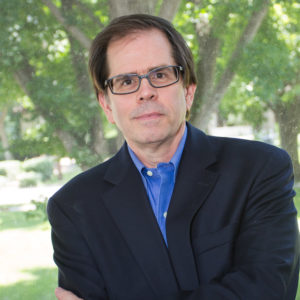
Timothy Kramer
Timothy Kramer’s music reflects his fascination with motivic patterns, cyclical relationships, and musical gestures that unfold in a variety of changing speeds and textures. Originally from Washington State, Kramer (b. 1959) began playing the piano at an early age, and, although trained as a pianist, organist, and harpsichordist, he spent many years as a youth playing bass guitar in jazz and rock ensembles. His music reflects this influence, and he sometimes integrates various aspects of American popular music into his pieces.
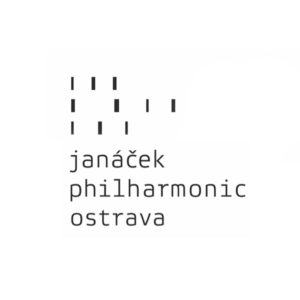
Janáček Philharmonic Ostrava
The Janáček Philharmonic is a world-class symphony orchestra based in Ostrava, Czech Republic and an emerging figure on the international performance scene. With over 100 top-level musicians, the orchestra aims to introduce unique, quality repertoire while showcasing their own recognizable sound.
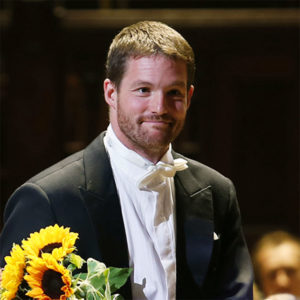
Jiří Petrdlík
Jiří Petrdlík (b. 1977) is appreciated as one of the most respectable conductors of his generation. He studied piano, trombone, and conducting — 1995–2000 at Prague Conservatory, and 2000–2005 at Academy of Performing Arts Prague — with Hynek Farkač, Miroslav Košler, Miriam Němcová, Radomil Eliška, and Tomáš Koutník, and took part in the masterclasses of the New York Philharmonic Principal Conductor Kurt Masur and the BBC Philharmonic Principal Conductor Jiří Bělohlávek. Petrdlík also successfully took part in several competitions, including the Donatella Flick Conductor Competition in London.
Notes
Timothy Kramer has long been admired as a composer of exceptionally well-crafted music. By the time I came to know him as a colleague at Trinity University, in the early 2000s, he was known equally to students as a gifted teacher of both music theory and composition. A native of the Pacific Northwest, Kramer (b. 1959) attended Pacific Lutheran University, where his dual interests in music theory and composition manifested early, combined with keyboard studies on the organ. He played bass guitar in jazz ensembles and with friends in bands; for recreation he played jazz piano. He went on to attend the University of Michigan for his masters and doctorate degrees. Important influences on him as a musician were his composition teachers, including David Robbins, William Albright, Leslie Bassett, and William Bolcolm, and his first organ professor David Dahl, along with harpsichordist Edward Parmentier. His German heritage inspired him to study on a Fulbright program with Martin Redel at the Hochschüle für Musik in Detmold, Germany, in 1989. The meticulous nature of his later compositional voice emerged from these tributaries. He was hired at Trinity University immediately after the completion of his doctoral studies in 1991.
In San Antonio TX he established the city’s first-ever composer’s collective, the Composers Alliance of San Antonio, to foster friendships and collaborations between the region’s composers. His cordial good cheer and record of professional accomplishment made him a guiding spirit for that group. Since 2010, he has been on the faculty of Illinois College, having left Trinity after 19 years to help strengthen a music program at the small liberal arts college in central Illinois. As a composer, Kramer received accolades and honors from the start, including an ASCAP Young Composer’s Grant for his earliest orchestral work, Sentinels of the Dance (1986) (a work heard on this album) a National Endowment for the Arts grant (Concerto for Organ and String Orchestra, 1994), a Guggenheim Memorial Fellowship, and a residency at the MacDowell Colony.
Looking back over his career, Kramer has come to see Sentinels of the Dance as a guiding metaphor for the path his orchestral writing would go on to follow. Most of his commissions have been for smaller ensembles or soloists, enjoying numerous repeat performances. Sentinels stands as a marker at the beginning of his career; in different ways each of his later orchestral scores returns to its principles, suggesting an abstract, circular pattern to the growth of his style characterized by different expressions of an inwardly consistent temperament. Two of the works on this album were commissions from community orchestras, reinforcing his commitment to be able to compose music for any ensemble. Other recent commissions have come from the Utah Arts Festival, the Detroit Chamber Winds, and the San Francisco Choral Artists.
— Carl Leafstedt, Trinity University
The following notes were provided by the composer himself for the works on this album:
Symphony B-A-C-H (2007), the largest work on this recording, initially began as a series of essays all drawn from the name of Bach. Each movement explores a different aspect of musical texture, beginning with polyphony, then moving to monophony, homophony, and cacophony. The whole work is symphonic in scope. Two louder movements surround an interior scherzo (Schizo-Scherzo) and slow movement (Meditation CHorale). The first and last movements were premiered in 2000 and 2007, respectively, by the San Antonio Symphony.
For the first movement, BACH meets EsCHeR, I was thinking about the concepts of polyphony, and I could not ignore the overwhelming influence of J.S. Bach's music. I was also intrigued by the connections made by Douglas Hofstadter in his book Gödel, Escher, Bach: An Eternal Golden Braid. The graphic designs of M.C. Escher became a kind of visual impetus for this work, dictating clear rhythmic gestures with independent parts that reveal a larger organic structure. I decided, therefore, to base the first essay on the names of Bach and Escher. After a slow beginning based on the musical pitches in their names (the “R” in EsCHeR is the syllable “re” in solfège terms), a faster central section takes the BACH motive and builds different polyphonic textures which transform themselves into chords. This leads to a fugue, where BACH and EsCHeR meet again as subject and countersubject.
Schizo-Scherzo is a single line orchestrated to point out rhythmic and textural development. It relies primarily upon the winds, with a delicate Trio section, and uses small quotations of scherzos by Beethoven and Mahler that are buried within its texture.
Meditation CHorale is a very slow movement that focuses on two pitches: C and B natural. These two pitches are present throughout the entire movement —in every measure— while the homophonic chorale moves above and below, gaining strength and power and increasing in register. This movement relies primarily upon the strings.
Party Favors uses noise sounds and a blending of musics at different speeds to create a variety of surprising textures. The percussion section takes control while many of the other instruments play in a percussive manner using the chromatic collection of BACH to build cacophonous sounds in an ironic homage. Here the four-note motive is worked into a variety of vernacular rhythms and short melodies infused with elements of swing, funk, and salsa. These episodes or “party favors” each become wildly exaggerated and take us back to the opening material.
A Fivescore Festival (1990) was commissioned by the City of Kent WA in celebration of their Centennial and written specifically for and premiered by the Rainier Symphony Orchestra. Because this was a commission using community funds, the City was fairly specific as to the type of work they wanted. The work was to be "festive, uplifting, and accessible to the general public, celebrating the settlement of the valley and the city." The piece is a series of four preludes and a rondo. Although each prelude has a different character, they are all designed to lead to and prepare the rondo theme: D,E,Bb,A,G. This theme is overtaken in the rondo by a chorale taken from the first prelude and then treated in a fast coda. The piece reflects the strength and diversity of a community moving by generations toward a common goal.
Written with few limitations, Sentinels of the Dance (1986) is perhaps the "wildest" of my earlier works and my first orchestral work. Rhythmically influenced by jazz and rock, the opening section breaks up the orchestra in different combinations of attacks much like a gigantic trap set in which the conductor plays each member of the set in spontaneous, syncopated rhythms. In the second section, a kaleidoscope of colors sets the stage for the central dance in which both fast and slow music is heard simultaneously. The work was premiered by the University of Michigan’s University Symphony Orchestra, conducted by Gustav Meier, in February 1986.
All in Golden Measure (2013) was commissioned and premiered by the Jacksonville Symphony Society in Jacksonville IL to celebrate the 50th anniversary of their Symphony Orchestra. As I thought about what kind of piece to write for this occasion, I knew right away that I wanted to use material that the orchestra and audience would associate with Jacksonville. Because the orchestra started 50 years ago at MacMurray College and now performs at Illinois College, I thought it would be appropriate to base the piece on the Alma Maters from those institutions. I also thought the piece could unfold in golden proportions, where the themes are interwoven to create a rich texture. Finally, I wanted to add special sounds: the noise of train whistles that permeate all parts of Jacksonville, the sounds of cicadas that occur in regular cycles here, and the sound of the racetrack that resonates in the air on summer evenings.
— Tim Kramer
